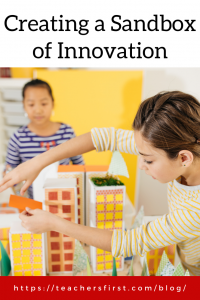Spring signifies new beginnings, progress, and the blossoming of new things. But did you know that May is also National Inventors Month? If it weren’t for inventors, you might be receiving this post through the telegraph or the Pony Express! National Inventor’s Month recognizes the talents of people who have impacted our world with their inventions. It’s also a great time for our students to develop the courage to share their creativity and ingenuity.
Explore an inventor’s workshop through the eyes of Leonardo da Vinci on Da Vinci the Genius, or encourage your students to research famous inventors in The National Inventors Hall of Fame. Design Squad Global is a fantastic resource from PBS Kids for fostering creativity and invention in your classroom.
Host an invention convention for your students. Start by posing a problem for students to solve and encourage them to organize their ideas through a concept map using Bubbl.us (reviewed here). Create presentations with Microsoft Sway (reviewed here) to share invention creations. Check out this collection of inventors and inventions for more resources to celebrate during May!
Develop creativity and ingenuity through Guilford’s model of divergent thinking. This collection of resources and information outlines steps that help students practice creativity in the classroom. Use different aspects of the FFOE framework for warmups or for activities on choice menus to help students establish a foundation for creativity. You can also check out DISRUPTUS by FoxMind, a game that revolves around new ways to create, transform, or improve ideas or objects.
These resources are an excellent starting place, but the question, posed in this video on the Rubik’s Cube, remains: How can teachers create a safe place in their classrooms to foster a community of learners seeking questions, not answers? The sandbox is an iconic symbol of early childhood play experiences. It was a space to explore, imagine, and create with limitless potential for play. Creating an active, authentic learning environment through a “sandbox approach” fosters self-directed learners and may inspire the next Grace Hopper! Data, standards, and scripted programs saturate our current classrooms, but the sandbox strategies below return the power to the learner.
- Techsploration – Provide opportunities for students to “techslpore” apps and resources before integrating them with projects. Offering this time in the classroom alleviates stress and anxiety when using a new tool during a project. Offer students the opportunity to be “techsperts” on applications to assist their classmates.
- PBL Experiences – Design project- or problem-based learning experiences that allow students to create and innovate. Students can demonstrate their knowledge of the learning objectives through choice and voice. PBL fosters teamwork, innovation, and communication in the classroom.
- Feedforward – Instead of providing feedback, work with students to provide information that helps them move forward with their designs and experiences.
We would love to hear about your ideas for supporting innovation and sandbox strategies in your classroom. Do you have tips to share with other educators? Share your thoughts in the comments below!


